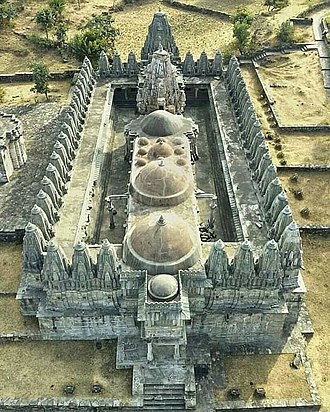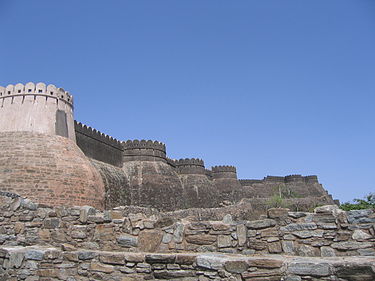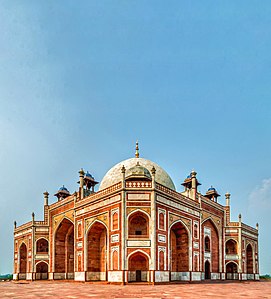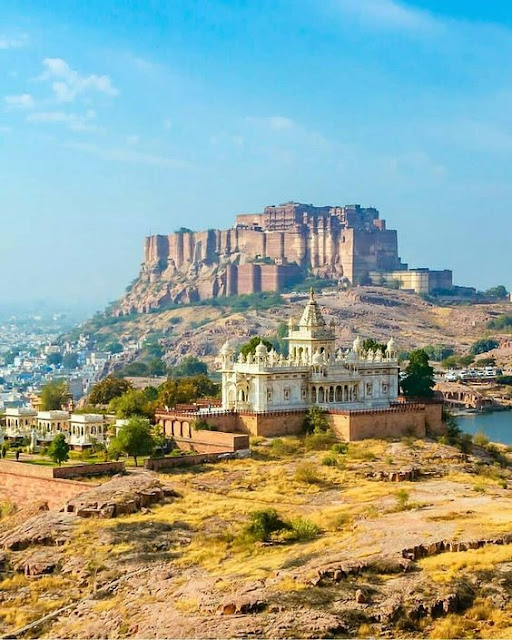Kumbhalgarh Fort: – History of Kumbhalgarh Fort, Rajasthan
Kumbhalgarh Fort
Kumbhalgarh Fort (or Kumbhal fort) is a Mewar fortress on the westerly range of Aravalli Hills, in the Rajsamand district near Udaipur of Rajasthan state in western India. It is a World Heritage Site included in Hill Forts of Rajasthan. Built during the 15th century by Rana Kumbha. Occupied until the late 19th century, the fort is now open to the public and is spectacularly lit for a few minutes each evening. Kumbalgarh is situated 82 km northwest of Udaipur by road. It is the most important fort in Mewar after Chittorgarh Fort.
In 2013, at the 37th session of the World Heritage Committee held in Phnom Penh, Cambodia, Kumbhalgarh Fort, along with five other forts of Rajasthan, was declared a UNESCO World Heritage Site under the group Hill Forts of Rajasthan.
With the walls of the fort extending over 38 km, it is claimed to be the second-longest continuous wall after the Great Wall of China; the fort is among the largest fort complexes in the world and the second-largest fort in India after Chittor Fort.
History
The early history of the fort could not be ascertained on account of a lack of evidence. The earliest name of the fort is believed to be Machhindrapur, while Sahib Haqim, a historian, named it Mahore. The original fort is believed to have been built by King Samprati of the Maura Age on account of strategic importance during the 6th century. The subsequent history till 1303 AD till the invasion of Alauddin Khalji is obscure.
Kumbhalgarh in its current form was built and ruled by Rana Kumbha and his dynasty who were Hindu Sisodia Rajputs descendants. Kumbhalgarh in its present form was developed by and believed to have been designed by a famous architect of the era Madan. Rana Kumbha's kingdom of Mewar stretched from Ranthambore to Gwalior and included large tracts of erstwhile Madhya Pradesh as well as Rajasthan. Out of the 84 forts in his dominion, Rana Kumbha is said to have designed 32 of them, of which Kumbhalgarh is the largest and most elaborate.
Kumbhalgarh also separated Mewar and Marwar from each other and was used as a place of refuge for the rulers of Mewar at times of danger. A notable instance was in the case of Prince Udai, the infant king of Mewar who was smuggled here in 1535 when Chittaur was under siege. Prince Udai later succeeded to the throne. The fort remained impregnable to direct assault, and fell only once to the forces of Mughal Emperor Akbar's General Mansingh I in 1576 after Mughal victory at the Battle of Haldighati.
Ahmed Shah I of Gujarat attacked the fort in 1457 but found the effort futile. There was a local belief then that the Banmata deity in the fort protected it and hence he destroyed the temple. There were further attempts in 1458–59 and 1467 by Mahmud Khalji, but it also proved futile. Akbar's general, Shahbaz Khan, is believed to have taken control of the fort in 1576. But it was recaptured by Maharana Pratap in 1585 through guerrilla warfare. Finally in 1615 Mewar surrendered against the Mughal forces sent by Emperor Jahangir under the command of Prince Khurram. In 1818, an armed band of Sannyasins formed a garrison to protect the fort, but was convinced by Tod and the fort was taken over by the British and later returned to Udaipur State. There were additions made by Maharanas of Mewar, but the original structure built by Maharana Kumbha remains. The residential buildings and temples are well-preserved. The fort is also known to be the birthplace of Maha Rana Pratap.
Jain Temples in the fort
Architecture
The massive gate of Kumbhalgarh fort called the Ram Pol (Ram Gate)
Built on a hilltop 1,100 m (3,600 ft) above sea level on the Aravalli range, the fort of Kumbhalgarh has perimeter walls that extend 36 km (22 mi), making it one of the longest walls in the world. The frontal walls are fifteen feet thick. Kumbhalgarh has seven fortified gateways. There are over 360 temples within the fort, 300 ancient Jain and the rest Hindu. From the palace top, it is possible to see kilometers into the Aravalli Range. The dunes of the Thar Desert can be seen from the fort walls.
According to popular folklore, Maharana Kumbha used to burn massive lamps that consumed fifty kilograms of ghee and a hundred kilograms of cotton to provide light for the farmers who worked during the nights in the valley.
Important structures in the fort
Aerial view of a portion of the Kumbhalgarh wall
Lakhota Tank is the most notable tank inside the fort, constructed by Rana Lakha from 1382–1421 CE. It is located on the Western side of Kelwara town and measures 5 km (3.1 mi) in length to 100 m (0.062 mi) to 200 m (0.12 mi) in width. The tank had a depth of 40 ft (12 m) during independence and since then has been raised to 60 ft (18 m). Art Pol is the gate on the western side, Halla Pol with a downward slope from the entrance, Ram Pol and Hanuman Pol near Bavadi are the major gates of the fort. There are inscriptions on the foot of idols in Hanuman Pol detailing the construction of the fort. Bad Shahi Bavdi is a stepped tank, believed to have been built during the invasion of Shahbaz Khan in 1578, the general of Akbar to provide water to the troops.Most buildings are visible from the Ram Pol, which is considered an architectural specimen.
Hindu Temple
A Ganesh temple built on a 12 ft (3.7 m) platform and is considered the earliest of all temples built inside the fort.[6] Neel Kanth Mahadeva temple is located on the eastern side of the fort built during 1458 CE. The central shrine of Shiva is approached through a rectangular enclosure and a structure supported by 24 huge pillars. The idol of Shiva is made of black stone and is depicted with 12 hands. The inscriptions indicate that the temple was renovated by Rana Shanga.
Jain Temple
Magnificent 52 Charities Jain Temple Kumbhalgarh
Parsva Natha temple (built during 1513), Jain temple on the eastern side and Bawan (52) Jain temples and Golera Jain temple are the major Jain temples in the fort. Mataji temple, also called Kheda Devi temple is located on the southern side of Neela Kanth temple. Mamdeo temple, Pital Shah Jain temple and Surya Mandir (Sun temple) are the other major temples inside the fort.
Culture
The Rajasthan Tourism Department organizes a three-day annual festival in the fort in remembrance of the passion of Maharana Kumbha towards art and architecture. Sound and light shows are organized with the fort as the background. Various concerts and dance events are also organized to commemorate the function. The other events during the festival are Heritage Fort Walk, turban tying, tug-of-war, and Mehendi Mandana among others.
Six forts of Rajasthan, namely, Amber Fort, Chittor Fort, Gagron Fort, Jaisalmer Fort, Kumbhalgarh, and Ranthambore Fort were included in the UNESCO World Heritage Site list during the 37th meeting of the World Heritage Committee in Phnom Penh during June 2013. They were recognized as a serial cultural property and examples of Rajput military hill architecture.






Comments